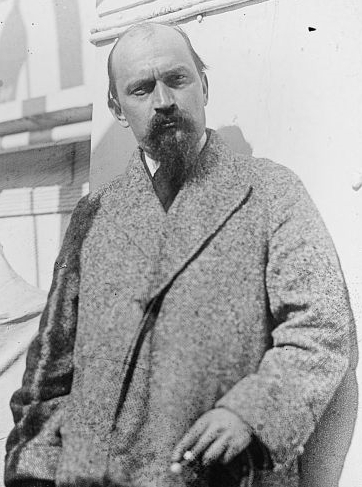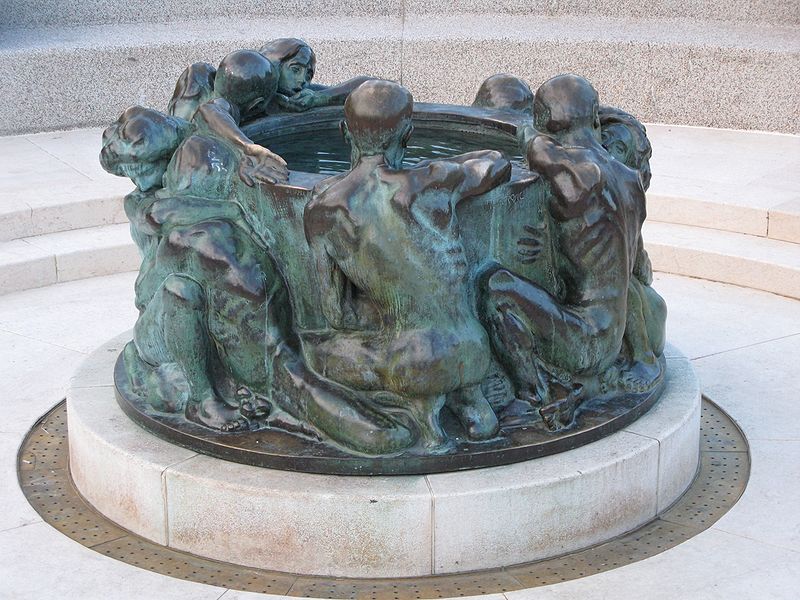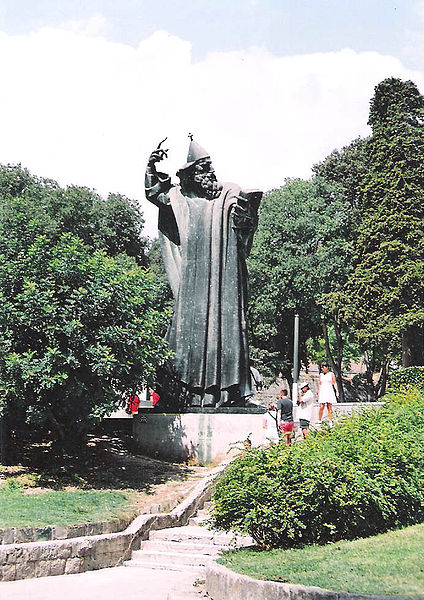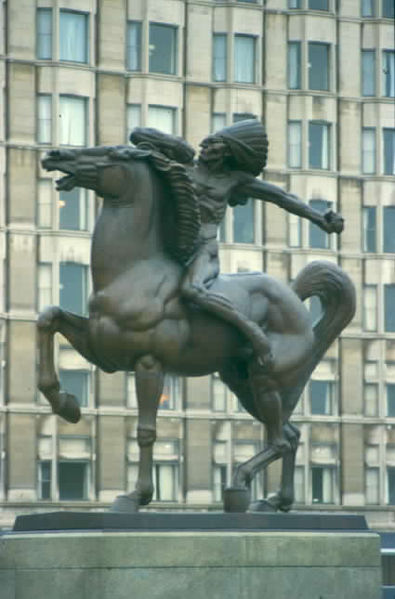<Back to Index>
- Physicist Louis Victor Pierre Raymond, Duc de Broglie, 1892
- Sculptor Ivan Meštrović, 1883
- Emperor of the French Napoleon Bonaparte, 1769

Ivan Meštrović (August 15, 1883 – January 16, 1962) was a Croatian sculptor born in Vrpolje, Croatia (then Kingdom of Croatia-Slavonia, an autonomous kingdom within the Austro-Hungarian Empire). He is renowned as possibly the greatest sculptor of religious subject matter since the Renaissance, the first living person to have a one man show at the Metropolitan Museum of Art in New York City.
He spent his childhood in Otavice, a small village located on the edge of Petrovo field in Dalmatian hinterland. At the age of sixteen, a master stone cutter from Split, Pavle Bilinić, noticed his talent and took him as an apprentice. His artistic skills were improved by studying the monumental buildings in the city and his education at the hands of Bilinić's wife, who was a high-school teacher. Soon, they found a mine owner from Vienna who paid for Meštrović to move there and be admitted to the Art Academy. He had to quickly learn German from scratch and adjust to the new environment, but he persevered and successfully finished his studies.
In 1905 he made his first exhibit with the Secession Group in Vienna, noticeably influenced by the Art Nouveau style. His work quickly became popular, even with the likes of Auguste Rodin, and he soon earned enough for him and his wife (since 1904) Ruža Klein to travel to more international exhibitions.
In 1908 Meštrović moved to Paris and the sculptures made in this period earned him international reputation. During this time, Ivan was a friend of the cubist painter Jelena Dorotka (Helene Dorotka von Ehrenwall). In 1911 he moved to Belgrade, and soon after to Rome where he received the grand prix for the Serbian Pavilion on the 1911 Rome International Exhibition. He remained in Rome to spend four years studying ancient Greek sculpture.
In the onset of the World War I, after the assassination in Sarajevo, Meštrović tried to move back to Split via Venice, but was dissuaded by threats made because of his political opposition to the Austro-Hungarian authorities. During the war he also travelled to make exhibits in Paris, Cannes, London and in Switzerland. He was one of the members of the Yugoslav Committee.
After the WWI he moved back home to the newly formed Yugoslavia and met the second love of his life, Olga Kesterčanek, whom he married shortly after. They had four children: Marta, Tvrtko, Maria and Mate, all of who were born in Zagreb, where they settled in 1922. He was a contemporary and friend of Nikola Tesla.
Mestrovic and family would later spend the winter months in their
mansion in Zagreb and the summer months in a summer house he built by
the end of the 1930s in Split. He became a professor and later the director of the Art Institute in Zagreb,
and proceeded to build numerous internationally renowned works as well
as many donated chapels and churches and grants to art students. By 1923 he designed the mausoleum for the Račić family at Cavtat, and he also created a set of statues for a never-built Yugoslav national temple that would be erected in Kosovo to commemorate the battle that happened there in 1389. He continued to travel to post his exhibits around the world: he displayed at the Brooklyn Museum in New York in 1924, in Chicago in 1925, he even traveled to Egypt and Palestine in 1927. In 1927 he entered a design for the coins of the Irish Free State, and though his design arrived too late for consideration it was adopted in 1965 as the seal of the Central Bank of Ireland. Being in conflict with both the Italians (since he opposed their irredentist territorial pursuit of Dalmatia) and the Germans (since he declined Hitler's invitation to Berlin in the 1930s), he was imprisoned for three and a half months by the Ustaše during World War II. With help from the Vatican he was released. He first travelled to Venice where he attended the Croatian pavilion at the Venice Biennale. From there he relocated to Rome, and later to Switzerland.
Unfortunately not all of his family managed to escape — his first wife
Ruža died in 1942 and many from her Jewish family were killed in the Holocaust. Later, his brother Petar was imprisoned by the emerging Communists, which further depressed the artist. Marshall Tito's government in Yugoslavia eventually invited Meštrović back, but he refused to live in a communist country.
In 1946, Syracuse University offered him a professorship, and he moved to the United States. He was awarded the American Academy of Arts and Letters' Gold Medal for sculpture in 1953. President Dwight D. Eisenhower personally presided over the 1954 ceremony granting Meštrović American citizenship. He went on to become a professor at the University of Notre Dame in 1955. Before he died, Meštrović returned to Yugoslavia one last time in order to visit the imprisoned Cardinal Alojzije Stepinac and Tito himself. At the request of various people from his homeland he sent 59 statues
from the United States to Yugoslavia (including the monument of Njegoš), and in 1952 even signed off his Croatian estates to the people, including over 400 sculptures and numerous drawings. The
early deaths of two of his children preceded his own. His daughter
Marta, who moved with him to the US, died in 1949 at the age of 24; his
son Tvrtko, who remained in Zagreb, was 39 when he died in 1961. In
1961, Meštrović's memoirs Uspomene na političke ljude i događaje were published by the Croatian emigrant publishing house Hrvatska revija (Croatian Review) in Buenos Aires, Argentina. In 1969, they were published by Matica hrvatska in Zagreb. After creating four clay sculptures to memorialize his children, Ivan Meštrović died in early 1962 at the age of 79, in South Bend, Indiana. In accordance with his wishes, his remains were transferred to a mausoleum in his childhood home of Otavice. His son Matthew (Mate) Meštrović is
an American university professor of Modern European history and worked
as a Contributing Editor of ”TIME”, served as a lieutenant in the US
Army PsyWar. He was president of the Croatian National congress and
lobbied on behalf of Croatian self determination in Washington, Western
Europe and Australia and a deputy in the Croatian Parliament, member
of Croatia’s delegation to the Council of Europe and the
Interparliamentary Union and served as ambassador in the Foreign
Ministry, recipient of Croatian and Bulgarian decorations. Because of
his father's and his own political anticommunist beliefs and
commitment to freedom was declared by the Yugoslav regime enemy Number
One of the Yugoslav State and a top CIA agent . His grandson Stjepan is a sociology professor at Texas A&M and author of several books.



